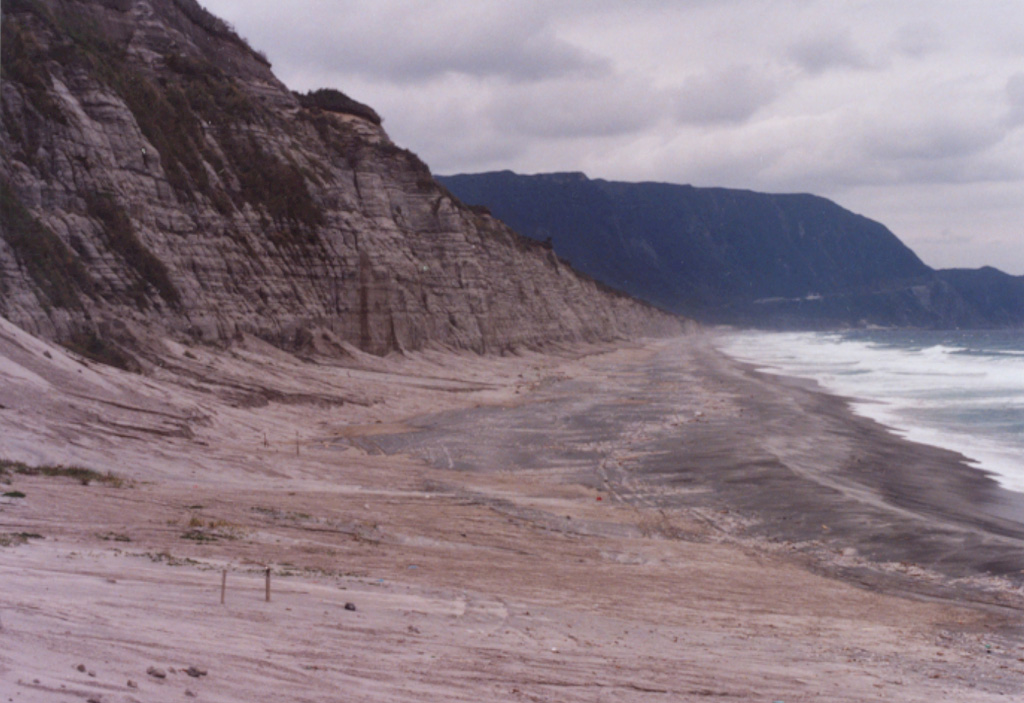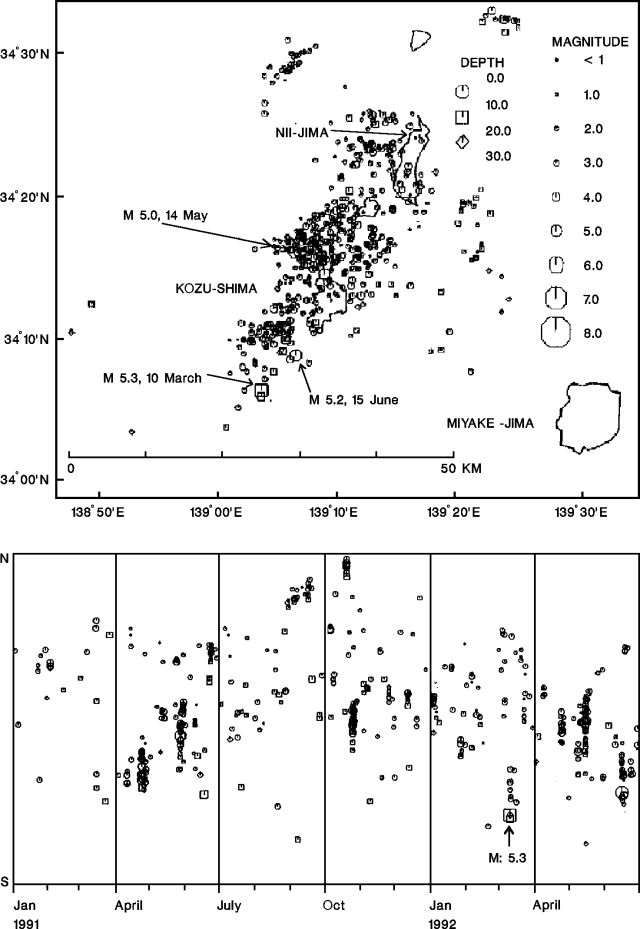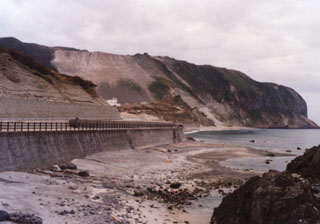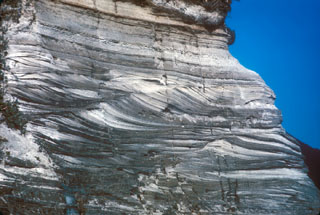

Seismic activity increases
High seismicity around the island was recorded on 17 and 24-26 July. The largest earthquakes (M 4.0) were detected at 1250 and 1321 on 17 July.
Information Contacts: Volcanological Division, Japan Meteorological Agency, 1-3-4 Ote-machi, Chiyoda-ku, Tokyo 100, Japan
The Global Volcanism Program has no Weekly Reports available for Niijima.
Reports are organized chronologically and indexed below by Month/Year (Publication Volume:Number), and include a one-line summary. Click on the index link or scroll down to read the reports.
Submarine earthquake swarm
Local seismicity increased in the sea NW of Nii-jima on 21-22 September. Residents measured no significant changes in temperatures of the island's hot springs during this period. Because epicenters were close to the island, more than 20 events were felt, the largest of magnitude [3.5 (JMA)]. Earthquake swarms are common around Nii-jima; the most recent was in August-September 1983 [when the largest event was M 4.2].
Information Contacts: JMA, Tokyo.
Earthquake swarm but no surface changes
An earthquake swarm was recorded on 3-4 January, centered 10 km SW of Nii-jima near Shikine-jima, a dome of the Nii-jima complex (figure 1). The largest shock, M 3.1, occurred at 0657 on 3 January. No surface anomalies were observed at the volcano or on the surrounding sea. Three weeks later, a swarm was recorded near Kozu-shima, 20 km SSW (figure 2).
 |
Figure 2. Epicenter map (top) and space/time diagram (bottom) showing seismicity around Kozu-shima and Nii-jima volcanoes, January 1991-June 1992. Courtesy of JMA. |
Information Contacts: JMA.
Earthquake swarm but no surface changes evident
A seismic swarm recorded between 0200 and 0400 on 19 March consisted of 10 earthquakes beneath and around the island (figure 3). Several of the events were felt by island residents, the largest, M 2.5, at 0349. No surface anomalies were observed.
Information Contacts: JMA.
Weak earthquake swarm
A weak earthquake swarm was detected in the sea a few kilometers E and W of the island on 28-29 August. The strongest event was M 2.3.
Information Contacts: JMA.
Two weak seismic swarms
Two weak earthquake swarms occurred 5 km WSW and NW of the island on 16 and 22 September. Maximum magnitudes were 3.5 and 3.1, respectively. No ocean-surface anomalies were observed.
Information Contacts: JMA.
Earthquake swarm but no surface changes evident
A swarm of earthquakes occurred midway between [Nii-jima and Kozu-shima] islands 17-20 October. The largest earthquake was M 5.1, at 2237 on 17 October. No ocean-surface anomalies were observed.
Information Contacts: JMA.
Earthquake swarm on 23 March; no surface anomalies
A weak earthquake swarm occurred 23 March in the N part of Nii-jima island. The earthquakes, M 1.9 maximum, were located both onshore and offshore. . . . No surface anomalies, onshore or offshore, were observed . . . .
Information Contacts: JMA.
Earthquake swarms
. . . An earthquake swarm on 9 September near Nii-jima island . . . included a M 3.7 event.
Information Contacts: JMA.
Seismic swarm on 4 December
On 4 December, many earthquakes occurred in and around the island, some of which were felt. The largest one was M 4.3.
Information Contacts: Volcanological Division, Seismological and Volcanological Department, Japan Meteorological Agency (JMA), 1-3-4 Ote-machi, Chiyoda-ku, Tokyo 100 Japan.
Seismic activity increases
High seismicity around the island was recorded on 17 and 24-26 July. The largest earthquakes (M 4.0) were detected at 1250 and 1321 on 17 July.
Information Contacts: Volcanological Division, Japan Meteorological Agency, 1-3-4 Ote-machi, Chiyoda-ku, Tokyo 100, Japan
This compilation of synonyms and subsidiary features may not be comprehensive. Features are organized into four major categories: Cones, Craters, Domes, and Thermal Features. Synonyms of features appear indented below the primary name. In some cases additional feature type, elevation, or location details are provided.
Synonyms |
||||
| Nii-jima | ||||
Cones |
||||
| Feature Name | Feature Type | Elevation | Latitude | Longitude |
| O-mine | Pyroclastic cone | 301 m | ||
Domes |
||||
| Feature Name | Feature Type | Elevation | Latitude | Longitude |
| Akazaki-no-mine | Dome | 429 m | ||
|
Atchiyama
Attiyama Achiyama |
Dome | 207 m | 34° 24' 22" N | 139° 17' 4" E |
|
Jinakayama
Zinaka-yama |
Dome | |||
|
Marushimayama
Marusima-yama |
Dome | 230 m | ||
|
Mineji
Minezi |
Dome | |||
| Miyazukayama | Dome | 432 m | ||
|
Mukaiyama
Mukoyama |
Dome | 301 m | 34° 20' 45" N | 139° 15' 45" E |
|
Niijimayama
Niizima-yama |
Dome | 238 m | ||
| Setoyama | Dome | |||
|
Shikinejima
Sikine-zima |
Dome | 105 m | ||
|
|
||||||||||||||||||||||||||||
There is data available for 5 confirmed Holocene eruptive periods.
0886 Jun 29 Confirmed Eruption VEI: 4
| Episode 1 | Eruption | Mukai-yama | ||||||||||||||||||||||||||||||||||||||||||||
|---|---|---|---|---|---|---|---|---|---|---|---|---|---|---|---|---|---|---|---|---|---|---|---|---|---|---|---|---|---|---|---|---|---|---|---|---|---|---|---|---|---|---|---|---|---|
| 0886 Jun 29 - Unknown | Evidence from Observations: Reported | ||||||||||||||||||||||||||||||||||||||||||||
|
List of 7 Events for Episode 1 at Mukai-yama
| |||||||||||||||||||||||||||||||||||||||||||||
0856 (?) - 0857 (?) Confirmed Eruption VEI: 2
| Episode 1 | Eruption | Achi-yama | |||||||||||||||||||||||||||||
|---|---|---|---|---|---|---|---|---|---|---|---|---|---|---|---|---|---|---|---|---|---|---|---|---|---|---|---|---|---|---|
| 0856 (?) - 0857 (?) | Evidence from Observations: Reported | |||||||||||||||||||||||||||||
|
List of 4 Events for Episode 1 at Achi-yama
| ||||||||||||||||||||||||||||||
1250 BCE (?) Confirmed Eruption
| Episode 1 | Eruption | Wakago tephra | ||||||||||||||||||||||||
|---|---|---|---|---|---|---|---|---|---|---|---|---|---|---|---|---|---|---|---|---|---|---|---|---|---|
| 1250 BCE (?) - Unknown | Evidence from Correlation: Tephrochronology | ||||||||||||||||||||||||
|
List of 3 Events for Episode 1 at Wakago tephra
| |||||||||||||||||||||||||
4350 BCE (?) Confirmed Eruption
| Episode 1 | Eruption | Niijima-yama | ||||||||||||||||||||||||
|---|---|---|---|---|---|---|---|---|---|---|---|---|---|---|---|---|---|---|---|---|---|---|---|---|---|
| 4350 BCE (?) - Unknown | Evidence from Correlation: Tephrochronology | ||||||||||||||||||||||||
|
List of 3 Events for Episode 1 at Niijima-yama
| |||||||||||||||||||||||||
5950 BCE (?) Confirmed Eruption
| Episode 1 | Eruption | ||||||||||||||||||||
|---|---|---|---|---|---|---|---|---|---|---|---|---|---|---|---|---|---|---|---|---|
| 5950 BCE (?) - Unknown | Evidence from Correlation: Tephrochronology | |||||||||||||||||||
|
List of 2 Events for Episode 1
| ||||||||||||||||||||
There is no Deformation History data available for Niijima.
There is no Emissions History data available for Niijima.
 Stratified phreatomagmatic deposits are exposed along a cliff on the eastern coast of Niijima, with the flat-topped Miyazukayama lava dome in the background. The 11-km-long island is comprised of eight rhyolite lava domes clustered in two groups. The Mukaiyama complex at the southern end of the island and Achiyama lava dome at the northern end formed during the 9th century CE.
Stratified phreatomagmatic deposits are exposed along a cliff on the eastern coast of Niijima, with the flat-topped Miyazukayama lava dome in the background. The 11-km-long island is comprised of eight rhyolite lava domes clustered in two groups. The Mukaiyama complex at the southern end of the island and Achiyama lava dome at the northern end formed during the 9th century CE. The Mukaiyama lava dome lies at the southern end of the island of Niijima. It formed during a single eruption in July 886 CE beginning in shallow water with the formation of a tuff ring from repeated base surges, followed by a pyroclastic cone and lava domes.
The Mukaiyama lava dome lies at the southern end of the island of Niijima. It formed during a single eruption in July 886 CE beginning in shallow water with the formation of a tuff ring from repeated base surges, followed by a pyroclastic cone and lava domes.  A sequence of pyroclastic surge deposits exposed in a sea cliff on Niijima, in the northern part of the Izu Islands of Japan. These cross-bedded layers were produced during repeated erosion and deposition by multiple pyroclastic surge events. The eruptions accompanied the formation of a lava dome at Mukaijima on the southern part of the island. The flat airfall deposits cap the exposure.
A sequence of pyroclastic surge deposits exposed in a sea cliff on Niijima, in the northern part of the Izu Islands of Japan. These cross-bedded layers were produced during repeated erosion and deposition by multiple pyroclastic surge events. The eruptions accompanied the formation of a lava dome at Mukaijima on the southern part of the island. The flat airfall deposits cap the exposure.Maps are not currently available due to technical issues.
The following 2 samples associated with this volcano can be found in the Smithsonian's NMNH Department of Mineral Sciences collections, and may be availble for research (contact the Rock and Ore Collections Manager). Catalog number links will open a window with more information.
| Catalog Number | Sample Description | Lava Source | Collection Date |
|---|---|---|---|
| NMNH 108959 | Biotite Rhyolite | MUKO-YAMA DOME | -- |
| NMNH 117801-9 | Rhyolite | Muko-yama | -- |
| Copernicus Browser | The Copernicus Browser replaced the Sentinel Hub Playground browser in 2023, to provide access to Earth observation archives from the Copernicus Data Space Ecosystem, the main distribution platform for data from the EU Copernicus missions. |
| MIROVA | Middle InfraRed Observation of Volcanic Activity (MIROVA) is a near real time volcanic hot-spot detection system based on the analysis of MODIS (Moderate Resolution Imaging Spectroradiometer) data. In particular, MIROVA uses the Middle InfraRed Radiation (MIR), measured over target volcanoes, in order to detect, locate and measure the heat radiation sourced from volcanic activity. |
| MODVOLC Thermal Alerts | Using infrared satellite Moderate Resolution Imaging Spectroradiometer (MODIS) data, scientists at the Hawai'i Institute of Geophysics and Planetology, University of Hawai'i, developed an automated system called MODVOLC to map thermal hot-spots in near real time. For each MODIS image, the algorithm automatically scans each 1 km pixel within it to check for high-temperature hot-spots. When one is found the date, time, location, and intensity are recorded. MODIS looks at every square km of the Earth every 48 hours, once during the day and once during the night, and the presence of two MODIS sensors in space allows at least four hot-spot observations every two days. Each day updated global maps are compiled to display the locations of all hot spots detected in the previous 24 hours. There is a drop-down list with volcano names which allow users to 'zoom-in' and examine the distribution of hot-spots at a variety of spatial scales. |
|
WOVOdat
Single Volcano View Temporal Evolution of Unrest Side by Side Volcanoes |
WOVOdat is a database of volcanic unrest; instrumentally and visually recorded changes in seismicity, ground deformation, gas emission, and other parameters from their normal baselines. It is sponsored by the World Organization of Volcano Observatories (WOVO) and presently hosted at the Earth Observatory of Singapore.
GVMID Data on Volcano Monitoring Infrastructure The Global Volcano Monitoring Infrastructure Database GVMID, is aimed at documenting and improving capabilities of volcano monitoring from the ground and space. GVMID should provide a snapshot and baseline view of the techniques and instrumentation that are in place at various volcanoes, which can be use by volcano observatories as reference to setup new monitoring system or improving networks at a specific volcano. These data will allow identification of what monitoring gaps exist, which can be then targeted by remote sensing infrastructure and future instrument deployments. |
| Volcanic Hazard Maps | The IAVCEI Commission on Volcanic Hazards and Risk has a Volcanic Hazard Maps database designed to serve as a resource for hazard mappers (or other interested parties) to explore how common issues in hazard map development have been addressed at different volcanoes, in different countries, for different hazards, and for different intended audiences. In addition to the comprehensive, searchable Volcanic Hazard Maps Database, this website contains information about diversity of volcanic hazard maps, illustrated using examples from the database. This site is for educational purposes related to volcanic hazard maps. Hazard maps found on this website should not be used for emergency purposes. For the most recent, official hazard map for a particular volcano, please seek out the proper institutional authorities on the matter. |
| IRIS seismic stations/networks | Incorporated Research Institutions for Seismology (IRIS) Data Services map showing the location of seismic stations from all available networks (permanent or temporary) within a radius of 0.18° (about 20 km at mid-latitudes) from the given location of Niijima. Users can customize a variety of filters and options in the left panel. Note that if there are no stations are known the map will default to show the entire world with a "No data matched request" error notice. |
| UNAVCO GPS/GNSS stations | Geodetic Data Services map from UNAVCO showing the location of GPS/GNSS stations from all available networks (permanent or temporary) within a radius of 20 km from the given location of Niijima. Users can customize the data search based on station or network names, location, and time window. Requires Adobe Flash Player. |
| DECADE Data | The DECADE portal, still in the developmental stage, serves as an example of the proposed interoperability between The Smithsonian Institution's Global Volcanism Program, the Mapping Gas Emissions (MaGa) Database, and the EarthChem Geochemical Portal. The Deep Earth Carbon Degassing (DECADE) initiative seeks to use new and established technologies to determine accurate global fluxes of volcanic CO2 to the atmosphere, but installing CO2 monitoring networks on 20 of the world's 150 most actively degassing volcanoes. The group uses related laboratory-based studies (direct gas sampling and analysis, melt inclusions) to provide new data for direct degassing of deep earth carbon to the atmosphere. |
| Large Eruptions of Niijima | Information about large Quaternary eruptions (VEI >= 4) is cataloged in the Large Magnitude Explosive Volcanic Eruptions (LaMEVE) database of the Volcano Global Risk Identification and Analysis Project (VOGRIPA). |
| EarthChem | EarthChem develops and maintains databases, software, and services that support the preservation, discovery, access and analysis of geochemical data, and facilitate their integration with the broad array of other available earth science parameters. EarthChem is operated by a joint team of disciplinary scientists, data scientists, data managers and information technology developers who are part of the NSF-funded data facility Integrated Earth Data Applications (IEDA). IEDA is a collaborative effort of EarthChem and the Marine Geoscience Data System (MGDS). |